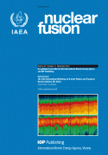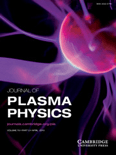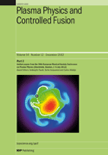
NUCLEAR FUSION
Scope & Guideline
Illuminating the path to sustainable energy solutions.
Introduction
Aims and Scopes
- Plasma Physics and Magnetohydrodynamics (MHD):
Research in this area includes the study of plasma behavior under various conditions, stability analyses, and simulations of magnetohydrodynamic phenomena, which are crucial for maintaining stable fusion reactions. - Tokamak and Stellarator Research:
Investigations into the design, operation, and optimization of tokamak and stellarator devices, focusing on confinement strategies, plasma heating methods, and control of edge localized modes (ELMs) to improve performance. - Material Science for Fusion Applications:
Studies on materials that can withstand the extreme conditions in fusion reactors, including investigations into erosion, tritium retention, and the effects of neutron irradiation on structural integrity. - Advanced Diagnostics and Control Systems:
Development and implementation of diagnostic tools and control systems for monitoring and regulating plasma parameters, enhancing operational efficiency and safety in fusion experiments. - Computational Modelling and Simulation:
Utilization of advanced computational techniques to model plasma behavior, transport phenomena, and material interactions in fusion environments, aiding in predictive capabilities for future reactors. - Fusion Reactor Design and Engineering:
Research related to the conceptual and engineering design of fusion reactors, including the integration of various subsystems and the evaluation of reactor performance under operational scenarios. - Energy Production and Sustainability:
Exploration of the broader implications of fusion energy, including its potential role in sustainable energy systems and strategies for achieving commercial viability.
Trending and Emerging
- Artificial Intelligence and Machine Learning in Fusion Research:
There is a growing trend in applying AI and machine learning techniques to optimize plasma control, predictive modeling, and data analysis, significantly enhancing the efficiency and accuracy of fusion research. - Advanced Divertor and Heat Exhaust Designs:
Research into innovative divertor designs and heat management strategies has escalated, driven by the need to handle the extreme heat loads expected in future fusion reactors, particularly with the rise of concepts like the Super-X divertor. - Nuclear Materials and Tritium Management:
Increased focus on the development of advanced materials for fusion reactors, particularly concerning tritium retention, erosion resistance, and the long-term sustainability of materials under fusion conditions. - Core-Edge Integration:
Studies emphasizing the interaction between core plasma and edge plasma dynamics are emerging as critical for improving overall confinement and stability in fusion devices. - Hybrid Scenarios and Operational Optimization:
Research into hybrid plasma scenarios that blend different confinement regimes is on the rise, focusing on optimizing operational parameters for enhanced performance in tokamaks.
Declining or Waning
- Inertial Confinement Fusion (ICF) Studies:
Research focusing on inertial confinement fusion has diminished as the community shifts its attention towards magnetic confinement methods, which are seen as more feasible for practical energy generation. - Basic Plasma Physics:
Although foundational research remains important, the focus on purely theoretical plasma physics without direct applications to fusion energy has decreased in favor of studies with immediate relevance to reactor design and operation. - Low-Energy Plasma Interactions:
Investigations into low-energy plasma phenomena have seen reduced emphasis, as the field increasingly prioritizes high-energy interactions that are more relevant to the conditions expected in fusion reactors. - Historical Review Articles:
The frequency of historical or retrospective analyses of past fusion research has declined, with a greater emphasis now placed on current advancements and future projections in the field.
Similar Journals

JOURNAL OF PLASMA PHYSICS
Exploring the dynamics of plasma phenomena.Welcome to the JOURNAL OF PLASMA PHYSICS, a premier publication dedicated to advancing understanding and research in the field of plasma physics. Published by Cambridge University Press, this journal has been a pivotal resource since its inception in 1967, supporting scholars and professionals engaged in the innovative exploration of plasma phenomena. With an impressive Q1 rating in Condensed Matter Physics, the journal not only holds a significant position in the academic community but also ranks within the top 50th percentile in the Scopus database. Although it currently does not offer open access, the journal provides a wealth of valuable research contributions aimed at fostering knowledge and collaboration among researchers, professionals, and students alike. The Journal of Plasma Physics is committed to publishing high-quality articles that push the boundaries of knowledge, ensuring its vital role in the ever-evolving landscape of physics research.

PLASMA SCIENCE & TECHNOLOGY
Unraveling the Mysteries of Plasma BehaviorPLASMA SCIENCE & TECHNOLOGY is a distinguished academic journal published by IOP Publishing Ltd, focusing on the realm of condensed matter physics. With its inception in 2000 and continuing through 2024, the journal serves as a vital platform for disseminating groundbreaking research and developments in plasma science, encompassing experimental and theoretical studies that advance our understanding of plasma behavior and its applications. Although the journal is not open access, its insights are invaluable for researchers, professionals, and students devoted to the intricate physics of plasmas, particularly given its respectable Q2 quartile ranking within its category as of 2023 and a notable Scopus rank that places it within the 44th percentile among its peers. Published from the United Kingdom, the journal aims to foster collaboration and innovation in this essential field of study.

PLASMA PHYSICS AND CONTROLLED FUSION
Unraveling the Mysteries of Plasma for Controlled FusionPLASMA PHYSICS AND CONTROLLED FUSION is a leading academic journal published by IOP Publishing Ltd that focuses on advancing the understanding of plasma physics and its applications in the field of controlled fusion. Established in 1984, this prestigious journal has earned a significant reputation, demonstrated by its Q1 rankings in both Condensed Matter Physics and Nuclear Energy and Engineering for 2023, alongside impressive Scopus rankings placing it in the 79th percentile in its category. The journal serves as an essential platform for researchers, professionals, and students seeking to stay abreast of cutting-edge developments in plasma behavior, fusion technologies, and theoretical frameworks. While it does not currently offer open access options, the journal's rigorous peer-review process ensures the dissemination of high-quality research that is crucial for the advancement of nuclear energy solutions and the broader field of physics. With its commitment to fostering innovative research and development, PLASMA PHYSICS AND CONTROLLED FUSION is a vital resource for those passionate about the future of energy and scientific exploration.

Nuclear Materials and Energy
Advancing the Future of Nuclear Science and EngineeringNuclear Materials and Energy is a premier open-access journal published by Elsevier, dedicated to the dynamic fields of nuclear science and materials engineering. Since its inception in 2015, the journal has made significant strides in disseminating cutting-edge research, establishing itself as a vital resource for researchers and professionals alike. With a commendable impact factor and ranked in the Q2 category for both Materials Science (miscellaneous) and Nuclear and High Energy Physics, and impressively in Q1 for Nuclear Energy and Engineering in 2023, Nuclear Materials and Energy stands out in the academic community. This journal aims to bridge the gap between fundamental research and practical applications, promoting innovative solutions in the efficient utilization of nuclear materials and energy technologies. Open access since 2015, the journal ensures wide dissemination and accessibility of crucial findings, making it an essential platform for advancing knowledge and fostering collaboration in these pivotal fields.

ATOMIC DATA AND NUCLEAR DATA TABLES
Advancing knowledge in atomic and nuclear physics.ATOMIC DATA AND NUCLEAR DATA TABLES, published by Academic Press Inc Elsevier Science, is a leading journal in the fields of atomic and molecular physics, as well as nuclear and high energy physics. With an ISSN of 0092-640X and an E-ISSN of 1090-2090, this esteemed journal has been providing comprehensive data tables and significant research insights since its establishment in 1969. Spanning until 2024, it continues to serve as an invaluable resource for researchers and professionals aiming to deepen their understanding of atomic interactions and nuclear processes. Holding a commendable Q2 ranking in both relevant categories, it is recognized for its impact, reflected in Scopus rankings, where it ranks 25th out of 87 in Nuclear and High Energy Physics, and 87th out of 224 in Atomic and Molecular Physics. While it does not offer open access, the journal remains a crucial repository for high-quality data essential for scientific endeavors and advancements in these complex fields.

Problems of Atomic Science and Technology
Bridging Theory and Application in Nuclear Physics.Problems of Atomic Science and Technology is a leading journal in the realm of nuclear physics and technology, published by the esteemed Kharkov Institute of Physics and Technology. With an ISSN of 1562-6016, this journal is dedicated to disseminating high-quality research and advancements in atomic sciences, contributing significantly to both academic and practical applications in the field. Although not an open access publication, it ensures rigorous peer review standards to maintain the integrity and relevance of cited works. The journal seeks to provide a vital platform for researchers, professionals, and students who are engaged in the exploration of atomic phenomena, nuclear engineering, and associated technologies. Published from Kharkov, Ukraine, the journal also serves as a bridge for international collaboration and innovation, making it indispensable for anyone looking to stay at the forefront of atomic science research.

PLASMA PHYSICS REPORTS
Illuminating the Dynamics of Plasma PhysicsPLASMA PHYSICS REPORTS, published by PLEIADES PUBLISHING INC, is a distinguished journal that caters to the intricate and evolving field of plasma physics and its applications within condensed matter physics and astronomy. With an ISSN of 1063-780X and an E-ISSN of 1562-6938, the journal serves as a pivotal platform for researchers, professionals, and students to disseminate groundbreaking work and foster collaboration among experts in the field. The journal operates as a non-open access resource, contributing to its reputation for curating high-quality research findings. Over its converged years from 1996 to 2024, the journal has established itself within the Q3 category across both condensed matter physics and miscellaneous physics and astronomy in the 2023 quartiles. With current Scopus rankings placing it in the 42nd percentile for physics and astronomy and the 27th percentile for condensed matter physics, PLASMA PHYSICS REPORTS stands as a vital resource for advancing knowledge and innovation in plasma research.

INDIAN JOURNAL OF PHYSICS
Catalyzing Discussions in the Realm of PhysicsINDIAN JOURNAL OF PHYSICS, published by the Indian Association for Cultivation of Science, serves as a pivotal platform for researchers and scholars in the field of physics and astronomy. With its ISSN 0973-1458 and E-ISSN 0974-9845, this journal is committed to presenting innovative research and developments across diverse topics in physics, covering both theoretical and experimental studies. The journal has made its mark in the academic community, evidenced by its classification in the Q3 category within the Physics and Astronomy domain as of 2023, and ranks #100 out of 243 in the Scopus curated database, placing it in the 59th percentile. Spanning from 2005 to 2024, the INDIAN JOURNAL OF PHYSICS aims to foster knowledge exchange and stimulate discussions among physicists and scientific enthusiasts. Whether you are a researcher looking to publish your findings, a professional seeking updates in your field, or a student eager to explore varying aspects of physics, this journal is an invaluable resource contributing significantly to the understanding and advancement of physics in India and beyond.

Recent Contributions to Physics
Championing open access to transformative physics insights.Recent Contributions to Physics is a distinguished journal published by AL-FARABI KAZAKH NATIONAL UNIVERSITY, focusing on the latest developments and research breakthroughs in the field of physics. Established as an open access journal since 2008, it aims to facilitate the wide dissemination of knowledge by allowing researchers, professionals, and students worldwide to access high-quality content without barrier. Featuring a diverse range of topics within physics, from theoretical innovations to practical applications, this journal is an essential resource for anyone seeking to stay at the forefront of scientific advancement. Its commitment to quality and accessibility not only enhances the impact of research in the scientific community but also promotes collaboration across disciplines. With its dedication to fostering a vibrant academic dialogue, Recent Contributions to Physics is poised as a key contributor to the future of physics research.

PHYSICS OF PLASMAS
Connecting Fundamental Research with Real-World ApplicationsPhysics of Plasmas is a premier peer-reviewed journal published by AIP Publishing, focusing on the vital and interdisciplinary field of plasma physics. With an ISSN of 1070-664X, this journal presents cutting-edge research that spans a wide array of topics including fusion energy, astrophysical plasmas, and industrial applications of plasma technologies. As a recognized leader in the field, it holds a prestigious Q1 ranking in Condensed Matter Physics, reflecting its high impact and quality of published work. The journal's scope encompasses both fundamental studies and innovative applications, serving as an essential resource for researchers, professionals, and students alike. Although it does not offer open access, its rigorous selection process ensures that only the most significant contributions are highlighted. With a convergence of expertise from 1994 to 2024, Physics of Plasmas continually shapes the future of plasma research and technology, making it a critical avenue for sharing discoveries and advancements in this dynamic area of physics.